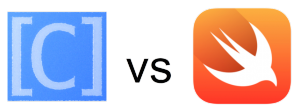Differences Between Swift and Objective-C

Apple used Objective-C, the programming language, for years to develop their iOS and OS X systems. Recently, they’ve moved away from Objective-C and created their own language, Swift. Apple now uses Swift as their primary programming language. It’s been dubbed as “Objective-C without the C”, and that has left us wondering: How different are the two languages? Here we’ll explain the differences between Swift and Objective-C.
Swift is Easier to Read
One difference between Swift and Objective-C is that Swift is easier to read. Because Objective-C was built on C, it had some problems to work around. Swift however has unified keywords, dropped the @ symbol, reduced brackets, and reduced semicolons. This simple syntax is more like the English language — and more like other object-oriented languages such as Java and Python.
Swift Requires Less Physical Code
Coding statements are simpler for Swift. Objective-C makes coders memorize certain tokens, and variables for those tokens. Swift eliminates that need, with a type-inference system. Also, one difference between Swift and Objective-C is that if you mess up the order of a string token in Swift, the app won’t crash. Overall it is far less prone to errors, and has a good support system for programmers.
Objective-C has More Bugs
If you’re writing Objective-C, and a line of code doesn’t work, it won’t crash — which is good, but it lets in bugs. Swift generates an error when you write bad code, or it will produce a runtime crash. This allows programmers to fix problems quickly, and ensures less bugs in the code. All this equates to less time and money being spent in the future, trying to get bugs out of the code.
There are plenty more differences between Swift and Objective-C, but these are three main ones. While it seems Swift is the better language, Objective-C is sometimes easier to learn, as much of it is derived from C.



